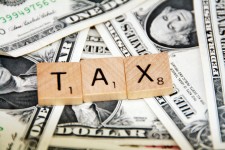
Self-employed workers, landlords and small business owners faced with ‘strangling’ quarterly returns.
- - Financial experts say move will add more red tape for small businesses
- - Plans to change were slipped out in George Osborne’s autumn statement
- - Government expects most self-employed people to file quarterly by 2020
Millions of earners are to be forced to file tax returns four times a year.
Self-employed workers, landlords and small business owners currently have to submit their figures just once every 12 months.
Switching them to quarterly returns will bring them into line with big corporations. But financial experts say the move will simply add to the reams of red tape already strangling small firms.
‘These changes are going to be very onerous,’ said Chas Roy-Chowdhury, of the Association of Chartered Certified Accountants.
‘It is not just about filling in a form, it is going to be a real burden.
‘Workers will have to make sure their books and records are up to date at least four times a year in case the taxman decides something is amiss and investigates them.’
Initially workers will not have to pay tax four times a year. But accountants suspect quarterly returns are a step towards this.
The plans were slipped out in the small print of George Osborne’s autumn statement. Around four million people will be affected: the self employed, small business owners and landlords who make more than £10,000 a year in profit.
The Government expects more self-employed workers to be filing quarterly and online by 2020. It will thrash out the details over the next year when the plans go out to consultation.
The first stage of the £1.3billion digital revolution at HMRC is expected soon with the launch of personal tax accounts for a millions workers. These will act like an internet bank account, and keep an up-to-the-minute record of tax paid.
At present every self-employed worker or small business owner need to file a paper return by October 31, or an online one by January 31. Tax must be paid by January 31.
Under the new system however, they will have to file online every three months – like big firms that report their financial results quarterly. They face having to use a complicated and lengthy online form each time.
As well as adding to the burdern of red tape, there are concerns that many small business owners could be fined for missing deadlines. Two in every five self-employed workers are either unable to use the internet or need help using Government online services, according to HMRC figures.
Fines of up to £100 are imposed for being a day late in filing.

Given its track record for poor customer service, there are also doubts as to whether HMRC will be able to roll out a system efficiently and with proper support for taxpayers. In June it emerged that the taxman had failed to answer 18million phone calls from the public in 12 months.
Small firms are already under pressure from the burden of setting up and paying into employee pension schemes.
And owners of small shops have complained of being forced to close by soaring business rates.
John Allan, of the Federation of Small Businesses, said he was deeply concerned about quarterly filing. ‘The annual tax return can be a major challenge and many smaller businesses still complete theirs manually,’ he said. ‘We believe the policy needs to be rethought. The push towards digital must be introduced alongside tax simplification and businesses should have a choice around the tax reporting process appropriate to them.’
Michelle Partington, 42, owner of small food business Lakeland Picnic, which is based near Kendal, Cumbria, said: ‘I could easily see how this could be a nightmare for some small business owners – especially one-man bands like plumbers.
‘When the Government first came to power it seemed to be very supportive of small business but it seems to have changed its approach. It is putting more and more things on us and putting barriers in the way of people who want to set one up.’
In their election manifesto, the Conservatives promised to cut £10billion of red tape and make Britain the best place in Europe to do business. In a recent speech to entrepreneurs, David Cameron hailed small business owners as ‘heroes and heroines’ and as Britain’s ‘life blood’.
A HMRC spokesman said: ‘Many taxpayers have told us they would like more certainty over their tax bill and we acknowledge that they shouldn’t have to wait until after the end of the year before being landed with an unexpected tax bill. That’s why we’re making it easier for them to update their tax information more regularly from 2018. We will ensure people have access to guidance and support where needed, including access to telephone filing.
‘Ninety-nine per cent of businesses already file their corporation tax online and 98 per cent of VAT returns are filed online. The new digital accounts simply integrate the different information businesses provide to HMRC into a simple, streamlined system.
‘We are focussed on creating a tax system that is more effective, more efficient and easier for taxpayers.’
This article was originally featured on www.dailymail.co.uk. You can read the article in full here.
Featured image via Flikr (CC.20)













 What’s more, Andrew’s many years of experience means that there are few situations that he has not encountered meaning the advice he offers is based on a working knowledge not text book learning.
What’s more, Andrew’s many years of experience means that there are few situations that he has not encountered meaning the advice he offers is based on a working knowledge not text book learning.